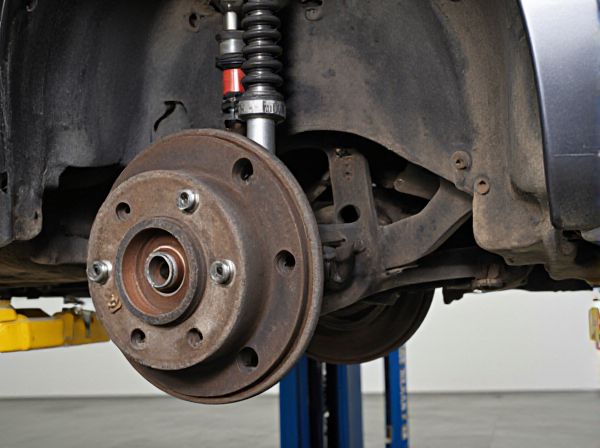
Photo illustration: Front Differential vs Rear Differential
The front differential directs power to the front wheels, enhancing steering and traction, especially in all-wheel and four-wheel drive vehicles. Rear differentials send power to the rear wheels, improving stability and control during acceleration and cornering. Understanding the role of each differential helps you maintain optimal vehicle performance and handling.
Table of Comparison
| Feature | Front Differential | Rear Differential |
|---|---|---|
| Location | Front axle | Rear axle |
| Function | Distributes power to front wheels | Distributes power to rear wheels |
| Common in | Front-wheel drive and all-wheel drive cars | Rear-wheel drive and all-wheel drive cars |
| Torque handling | Handles steering and power simultaneously | Handles power delivery only |
| Complexity | More complex due to steering mechanism | Less complex, fixed axle |
| Wear and Maintenance | Higher wear due to steering and power delivery | Generally lower wear, simpler design |
Introduction to Differentials: Purpose and Function
The front differential transfers engine power to the front wheels, enabling smooth turns by allowing them to rotate at different speeds, especially in front-wheel-drive and all-wheel-drive vehicles. The rear differential performs a similar function for the rear wheels, essential in rear-wheel-drive and all-wheel-drive systems for effective power distribution and improved traction. Both differentials reduce tire wear and enhance vehicle stability by compensating for the difference in wheel speed during cornering.
What is a Front Differential?
A front differential is a mechanical component in four-wheel-drive (4WD) and all-wheel-drive (AWD) vehicles that distributes engine torque to the front wheels, allowing them to rotate at different speeds during turns. It improves traction and handling on varying road surfaces by compensating for wheel speed differences while maintaining power delivery. Compared to a rear differential, the front differential is specifically designed to accommodate steering inputs and the complexities of front axle movement.
What is a Rear Differential?
A rear differential is a crucial component in the drivetrain of rear-wheel-drive and four-wheel-drive vehicles, responsible for distributing engine torque to the rear wheels while allowing them to rotate at different speeds during turns. It enhances traction and handling by compensating for the difference in wheel speed caused by cornering, preventing tire slippage and excessive wear. Compared to a front differential, which manages the front wheels, the rear differential primarily supports propulsion and stability in the vehicle's rear axle.
Key Differences: Front vs Rear Differential
Front differentials handle power distribution to the front wheels, enabling better traction and steering control, especially in all-wheel-drive vehicles. Rear differentials distribute torque to the rear wheels, often providing enhanced stability and acceleration in rear-wheel-drive cars. Key differences include their placement, the type of driveline they support, and their impact on vehicle handling dynamics.
Performance Impact: Handling and Traction
The front differential enhances handling and traction by distributing power to the front wheels, improving steering control and stability, especially in front-wheel-drive or all-wheel-drive vehicles. The rear differential optimizes performance by delivering power to the rear wheels, offering better acceleration and improved traction in rear-wheel-drive setups. Vehicles equipped with advanced differentials, such as limited-slip or locking types, benefit from increased grip and cornering ability, optimizing overall handling and traction balance.
Common Applications: Front vs Rear Differential in Vehicles
Front differentials are commonly used in front-wheel-drive vehicles, providing power to the front wheels for improved traction and handling, especially in compact cars and crossover SUVs. Rear differentials are typically found in rear-wheel-drive vehicles, including trucks, performance cars, and SUVs, delivering power to the rear wheels for enhanced stability and towing capacity. Four-wheel-drive and all-wheel-drive systems often integrate both front and rear differentials to optimize power distribution and traction across all wheels.
Maintenance Requirements for Each Differential Type
Front differentials typically require more frequent maintenance due to exposure to steering mechanisms and more complex drivetrain components, including regular inspection and lubrication of seals, bearings, and fluid changes. Rear differentials often have simpler maintenance needs but still demand periodic fluid replacement and seal checks to prevent leaks and ensure smooth operation. Both differential types benefit from timely service intervals based on manufacturer recommendations to extend component lifespan and maintain optimal vehicle performance.
Front Differential vs Rear Differential: Pros and Cons
The front differential enhances vehicle stability and traction on slippery or uneven surfaces by distributing power to the front wheels, benefiting off-road and all-wheel-drive vehicles, but it can add complexity and weight. Rear differentials contribute to better traction during acceleration and improved handling in rear-wheel-drive cars, offering durability and simpler maintenance, though they may struggle with traction on slippery roads. Choosing between front and rear differentials depends on driving conditions, vehicle type, and performance priorities such as off-road capability or sporty handling.
Impact on Off-Road and All-Wheel Drive Systems
The front differential improves traction and steering control on uneven terrain, essential for off-road vehicles navigating challenging obstacles. Rear differentials provide power distribution to rear wheels, enhancing stability and torque transfer in all-wheel drive (AWD) systems during off-road acceleration and climbing. AWD systems rely on coordinated front and rear differential function to optimize traction, reduce slippage, and improve overall vehicle handling in diverse off-road conditions.
Choosing the Right Differential for Your Vehicle
Choosing the right differential for your vehicle depends on your driving needs and terrain; front differentials provide better traction and control for off-road and slippery conditions, while rear differentials excel in stability and handling on dry pavement. Vehicles equipped with all-wheel drive or 4WD often utilize front differentials to distribute power to the front wheels, enhancing grip during acceleration and cornering. Understanding the torque distribution and traction benefits of front versus rear differentials helps optimize vehicle performance and safety.
 caratoz.com
caratoz.com